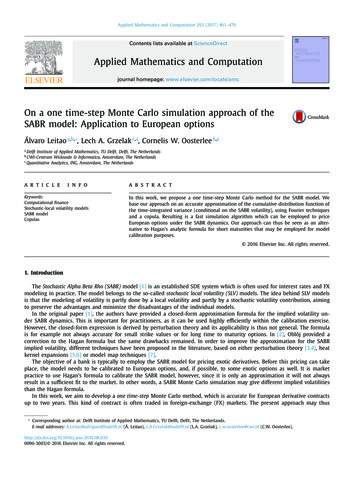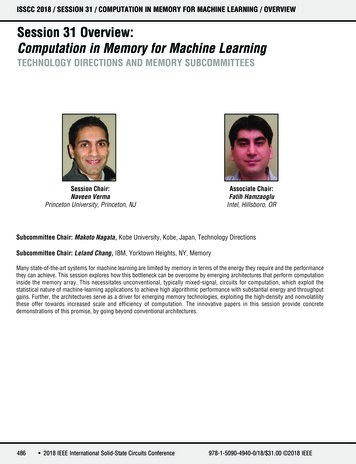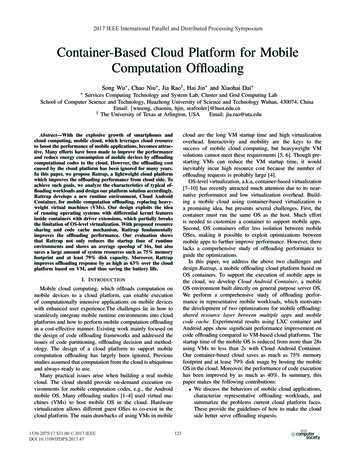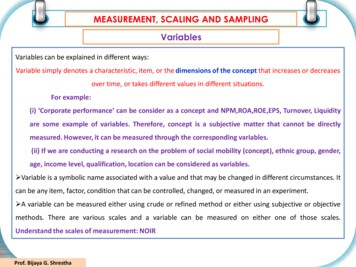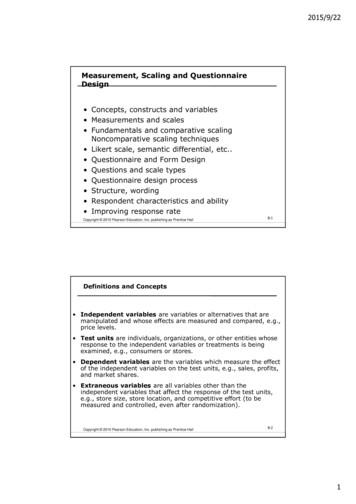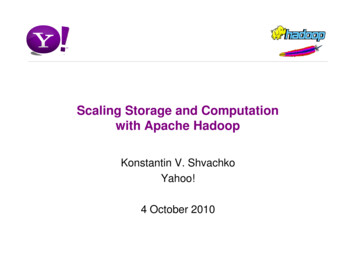
Transcription
Scaling Storage and Computationwith Apache HadoopKonstantin V. ShvachkoYahoo!4 October 2010
What is Hadoop Hadoop is an ecosystem of tools for processing“Big Data” Hadoop is an open source projectThe image cannot be display ed. Your computer may not hav e enough memory to open the image, or the image may hav e been corrupted. Restart y our computer, and then open the file again. If the red x still appears, y ou may hav e to delete the image and then insert it again. Yahoo! a primary developer of Hadoop since 2006
Big Data Big Data management, storage and analytics Large datasets (PBs) do not fit one computer– Internal (memory) sort– External (disk) sort– Distributed sort Computations that need a lot of compute power
Big Data: Examples Search Webmap as of 2008 @ Y!– Raw disk used 5 PB– 1500 nodes Large Hadron Collider: PBs of events– 1 PB of data per sec, most filtered out 2 quadrillionth (1015) digit of πis 0– Tsz-Wo (Nicholas) Sze– 23 days vs 2 years before– No data, pure CPU workload
Big Data: More Examples eHarmony– Soul matching Banking– Fraud detection Processing of astronomy data– Image Stacking and Mosaicing
Hadoop is the Solution Architecture principles:––––Linear scalingReliability and AvailabilityUsing unreliable commodity hardwareComputation is shipped to dataNo expensive data transfers– High performance
Hadoop ComponentsHDFSMapReduceDistributed file systemDistributed computationZookeeperDistributed coordinationHBaseColumn storePigDataflow languageHiveData warehouseAvroData SerializationChukwaData Collection
Hadoop Core A reliable, scalable, high performance distributedcomputing system Reliable storage layer– The Hadoop Distributed File System (HDFS)– With more sophisticated layers on top MapReduce – distributed computation framework Hadoop scales computation capacity, storage capacity,and I/O bandwidth by adding commodity servers. Divide-and-conquer using lots of commodity hardware
MapReduce MapReduce – distributed computation framework– Invented by Google researchers Two stages of a MR job– Map: { Key,Value } - { K’,V’ }– Reduce: { K’,V’ } - { K’’,V’’ } Map – a truly distributed stageReduce – an aggregation, may not be distributed Shuffle – sort and merge,transition from Map to Reduceinvisible to user
MapReduce Workflow
Mean and Standard Deviation1 nµ xin 1 Mean Standard deviation1 n2σ ( xi µ ) n 1nnn11122σ xi 2 µ ( xi ) µ 2n 1n 1n 1n122σ xi µ 2n 1
Map Reduce Example:Mean and Standard Deviation Input: large text file Output: µ and σ
Mapper Map input is the set of words {w} in the partition– Key Value w Map computes– Number of words in the partition– Total length of the words length(w)– The sum of length squares length(w)2 Map output– “count”, #words – “length”, #totalLength – “squared”, #sumLengthSquared
Single Reducer Reduce input– { key, value }, where– key “count”, “length”, “squared”– value is an integer Reduce computes– Total number of words: N sum of all “count” values– Total length of words: L sum of all “length” values– Sum of length squares: S sum of all “squared” values Reduce Output– µ L/N– σ S / N - µ2
Hadoop Distributed File SystemHDFS The name space is a hierarchy of files and directories Files are divided into blocks (typically 128 MB) Namespace (metadata) is decoupled from data– Lots of fast namespace operations, not slowed down by– Data streaming Single NameNode keeps the entire name space in RAM DataNodes store block replicas as files on local drives Blocks are replicated on 3 DataNodes for redundancy
HDFS Read To read a block, the client requests the list of replicalocations from the NameNode Then pulling data from a replica on one of the DataNodes
HDFS Write To write a block of a file, the client requests a list ofcandidate DataNodes from the NameNode, andorganizes a write pipeline.
Replica Location Awareness MapReduce schedules a task assigned to process blockB to a DataNode possessing a replica of B Data are large, programs are small Local access to data
Name Node NameNode keeps 3 types of information– Hierarchical namespace– Block manager: block to data-node mapping– List of DataNodes The durability of the name space is maintained by awrite-ahead journal and checkpoints– A BackupNode creates periodic checkpoints– A journal transaction is guaranteed to be persisted beforereplying to the client– Block locations are not persisted, but rather discoveredfrom DataNode during startup via block reports.
Data Nodes DataNodes register with the NameNode, and provideperiodic block reports that list the block replicas on hand DataNodes send heartbeats to the NameNode– Heartbeat responses give instructions for managingreplicas If no heartbeat is received during a 10-minute interval,the node is presumed to be lost, and the replicas hostedby that node to be unavailable– NameNode schedules re-replication of lost replicas
Quiz:What Is the Common Attribute?
HDFS size Y! cluster––––70 million files, 80 million blocks15 PB capacity4000 nodes. 24,000 clients41 GB heap for NN Data warehouse Hadoop cluster at Facebook––––55 million files, 80 million blocks21 PB capacity2000 nodes. 30,000 clients57 GB heap for NN
Benchmarks DFSIO– Read: 66 MB/s– Write: 40 MB/s Observed on busy cluster– Read: 1.02 MB/s– Write: 1.09 MB/s Sort (“Very carefully tuned user 7001000355880,00020,000TimeHDFS I/O Bytes/sAggregate(GB/s)Per Node(MB/s)62 s3222.158,500 s34.29.35
ZooKeeper A distributed coordination service for distributed apps– Event coordination and notification– Leader election– Distributed locking ZooKeeper can help build HA systems
HBase Distributed table store on top of HDFS– An implementation of Googl’s BigTable Big table is Big Data, cannot be stored on a single node Tables: big, sparse, loosely structured.––––Consist of rows, having unique row keysHas arbitrary number of columns,grouped into small number of column familiesDynamic column creation Table is partitioned into regions– Horizontally across rows; vertically across column families HBase provides structured yet flexible access to data
HBase Functionality HBaseAdmin: administrative functions– Create, delete, list tables– Create, update, delete columns, families– Split, compact, flush HTable: access table data–––––Result HTable.get(Get g) // get cells of a rowvoid HTable.put(Put p) // update a rowvoid HTable.put(Put[] p) // batch update of rowsvoid HTable.delete(Delete d) // delete cells/rowResultScanner getScanner(family) // scan col family
HBase Architecture
Pig A language on top of and to simplify MapReducePig speaks Pig LatinSQL-like languagePig programs are translated into aseries of MapReduce jobs
Hive Serves the same purpose as Pig Closely follows SQL standards Keeps metadata about Hive tables in MySQL DRBM
Hadoop User Groups
What is Hadoop Hadoop is an ecosystem of tools for processing “Big Data” Hadoop is an open source project Yahoo! a primary developer of Hadoop since 2006 The image cannot be displayed. Your computer may not have enough memory to open the image, or the image may have been cor
